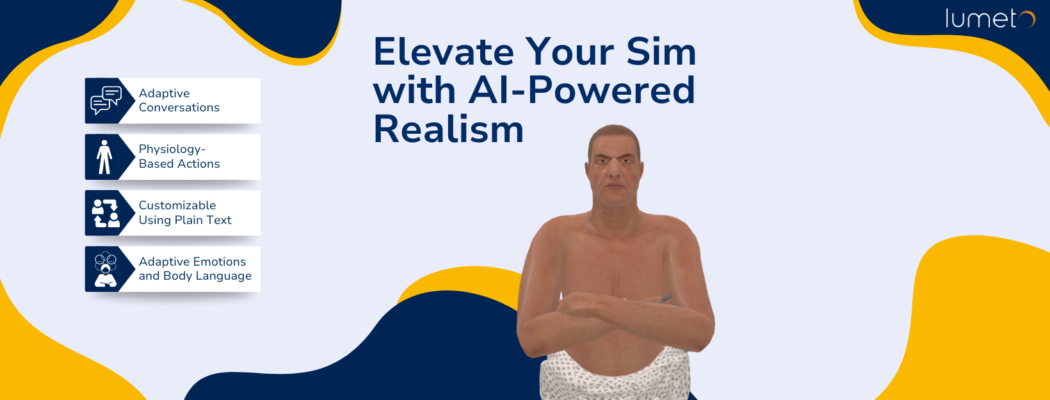
Lumeto Introduces InvolveXR AI Characters: A New Era in Healthcare Training, Revolutionizing Healthcare Simulation With Customizable AI-Enabled Virtual Humans
Toronto, ON – October 1, 2024 – Lumeto, a leader in immersive learning technology, is excited to announce the launch of InvolveXR AI Characters, a revolutionary solution set to transform the landscape of healthcare training. These first-of-its-kind customizable AI-powered virtual characters are uniquely capable of replicating high fidelity patient simulations, especially standardized patient training, traditionally reliant on live actors, at a fraction of the cost.
By integrating AI into customizable virtual patients that respond dynamically to learner interactions, InvolveXR AI Characters enable healthcare training programs to scale like never before—without compromising on realism or quality. For the first time, simulation directors can deploy immersive, high-fidelity healthcare scenarios that were once limited by high costs and resources.
A Game-Changer for Standardized Patient Training
Historically, healthcare simulation programs have relied on standardized patients—trained actors who portray specific medical conditions or psychosocial behaviors—to teach learners essential communication, assessment, and crisis management skills. However, these programs are expensive, resource-intensive, and difficult to scale.
InvolveXR AI Characters change the game by offering a virtual supplement with equally high fidelity. These AI-powered characters can be created using plain text and customized to reflect various medical and psychosocial conditions, all while delivering real-time verbal, non-verbal, and physiological responses. This capability allows healthcare programs to train more learners, across more scenarios, at a drastically lower cost than traditional standardized patient models.
Transformational Impact on Healthcare Training
The ability to scale standardized patient training with AI-driven virtual patients marks a transformational point in healthcare education. With InvolveXR AI Characters, healthcare programs can simulate high-pressure clinical environments, such as patient de-escalation and crisis management, with unmatched realism and efficiency. This shift allows educators to deliver robust learning experiences, empowering healthcare professionals to practice vital skills in diverse, immersive scenarios without the logistical limitations of human actors.
Key Benefits of InvolveXR AI Characters for Healthcare Training:
- For Learners: Learners can immerse themselves in complex, high-cognition healthcare scenarios with AI characters that respond in real time, helping to build and reinforce critical skills such as patient engagement, clinical decision-making, and crisis de-escalation. With the added flexibility of synchronous and asynchronous simulation, learners can train at their own pace, improving both confidence and competence.
- For Trainers: Trainers can focus on guiding the learning process, as InvolveXR AI Characters autonomously manage patient responses. This reduces the cognitive burden on trainers during live simulation sessions, allowing for a greater emphasis on learner engagement and reflection on patient outcomes.
- For Program Directors: With InvolveXR, healthcare programs can scale their standardized patient training significantly, providing a high fidelity experience to more learners with fewer resources. Directors can expand their offerings with minimal investment, leading to improved return on investment (ROI) and broader learner impact. Programs that previously required large teams of standardized patients and complex scheduling can now operate more efficiently and at optimized costs.
I have been struck by how working with AI patients on Lumeto’s InvolveXR platform evokes an emotional response that mirrors interactions with human patients. The joy of making a breakthrough in patient communication or the sadness felt during a patient’s distress highlights the system’s realism and immersiveness. This emotional engagement makes each simulation a powerful tool for honing empathetic and professional skills as a nurse.
Kimberly Workum RN, BScN, MEd, CHSE, CCNE
Director, Clinical Competence Assessment Centre and Digital Strategies, University of Manitoba
Industry-Leading Features of InvolveXR AI Characters:
- AI-Driven Virtual Patients Created from Plain Text: Educators, Simulation Designers and Trainers can generate fully interactive virtual patients using simple text descriptions, ensuring a lifelike training experience that can be accessed anywhere, anytime.
- Seamless Real-Time Conversations: AI characters engage learners in natural, evolving conversations based on their actions within the simulation. This feature enables healthcare professionals to hone essential communication and psychosocial interaction skills in a safe, realistic environment.
- Physiology-based Patient Actions and Symptoms: The virtual characters simulate a wide range of medical conditions, such as stroke or cardiac arrest, challenging learners to perform real-time clinical assessments and critical thinking in line with changing patient states.
- Realistic Behavioral Non-Verbal Responses: Beyond verbal interactions, AI characters exhibit body language and facial expressions reflective of their psychosocial and physiological condition, helping learners develop key communication, de-escalation and patient-caregiver engagement skills.
“Truly what we’re unlocking is the access to high fidelity patient simulation that’s scalable, effective and, most importantly, adaptable to every learner, every trainer and every program. This means way more realistic experiential learning opportunities with optimized training resources. We’re very excited to be able to enable meaningful use cases of AI for healthcare training.”
Raja Khanna
CEO and Founder of Lumeto
A New Era in Healthcare Simulation
InvolveXR AI Characters bring a new era of flexibility, affordability, and high fidelity to healthcare simulation. With cost-effective scalability, training programs can reach more learners, deliver more simulations, and improve skill development without the logistical challenges or expenses associated with traditional standardized patient programs. Lumeto is proud to lead this transformation, offering a tool that will reshape how healthcare professionals are trained and prepared to excel in real-world clinical environments.
About Lumeto
Lumeto is a trailblazer in immersive learning and simulation technologies, driving innovation in healthcare training with its cutting-edge virtual reality and AI-powered solutions. With InvolveXR AI Characters, Lumeto continues its mission to advance the quality and accessibility of healthcare education worldwide.
For more information, visit: Lumeto or contact: shruti.natarajan@lumeto.com